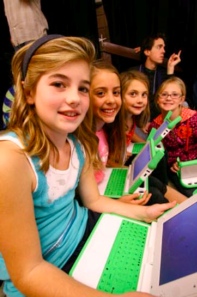In late November 2008, several students and faculty members from the University of California, Santa Barbara, joined together to form One Laptop per Child, Santa Barbara.
We began as a diverse bunch from Chemical Engineering, Computer Science, Technology Management, Global & International Studies, Psychology, and of course Education- but we were all equally impacted and inspired by the XO during a recent presentation on campus by Calestous Juma, professor at Harvard University and board member of OLPC.
As several months have passed, and our program has progressed, it is due time to give the OLPC News community a short update on what we've been up to! Here is an abridged account of our past few months together...
Lets start with the basics. We began as a small group of passionate individuals who were inspired, excited, and wanted to do something great with the XO. The only question was, what exactly could we do?
XOs were already traveling all over the globe, so it seemed just working to increase their distribution wouldn't be too necessary. We also knew that we wanted, in some way, to really involve the Santa Barbara and UCSB community, since we have a truly exceptional pool of talent and resources to draw from.
Ultimately, we came up with 4 main objectives that our group, OLPCsb was to focus on:
- Bringing the XOs to Classrooms:
We wanted to bring the XO to California Elementary students, starting with those in our local area. We knew the great potential these laptops had for children's learning in developing countries, so how could they be applied and adapted to classrooms in California? - Providing The Learning Tools:
When bringing the XOs to California classrooms, we also needed to help provide the tools and support for integrating the XOs into classrooms. This basically would consist of finding ways to apply existing XO Activities to the curriculum of local classrooms. We also wanted to utilize our talent pool of Software Engineers, Psychology and Education students here at UCSB to create new XO activities to fit local classroom curriculums. - Facilitating International Peer 2 Peer Partnership Program:
This was our biggest hope for "added value" to the OLPC community. We wanted to use the XOs to facilitate cross cultural learning and understanding among children. We felt that simply using this incredible technology to put kids from Africa and California in direct contact with each other, we would have an extremely powerful impact. We wanted to begin an "E-Pals" type program, where students could record video messages and share them with their international peers. In time we hoped this would progress to where both classrooms could work on collaborative projects, learning about each others region, geography, culture, way of life, etc - Documentation/ Creating a Resource Model:
We wanted to properly document, assess, and create a resource model out of our efforts that would be used to replicate the OLPC, SB Model throughout the United States, helping groups like us implement local programs and connect internationally.
It's been about six months into our organization, so you may wonder "well what have you done?" For sake of clarity and understanding, I'd like to break it down into the progress of each object. It flows quite nicely that way, and will allow me to tell our story sequentially over the next several weeks.
This post was essentially meant as an introduction to OLPCsb, and we hope it has served its purpose in that regard. Our Next post will be focused exclusively on how we introduced the XOs into the classroom, and how we have managed them so far. Hope you stay tuned!



At PS 5 in the South Bronx every student has an XO. Fifth graders produced a documentary highlighting the impact these devices have had on teaching and learning in the school. Through narrative and teacher and student interviews these student producers make a strong case for low cost computing in elementary schools.
Click the link below to view the video:
http://www.dailymotion.com/video/x9mj1k_xo-project-documentary-class-501-po_tech